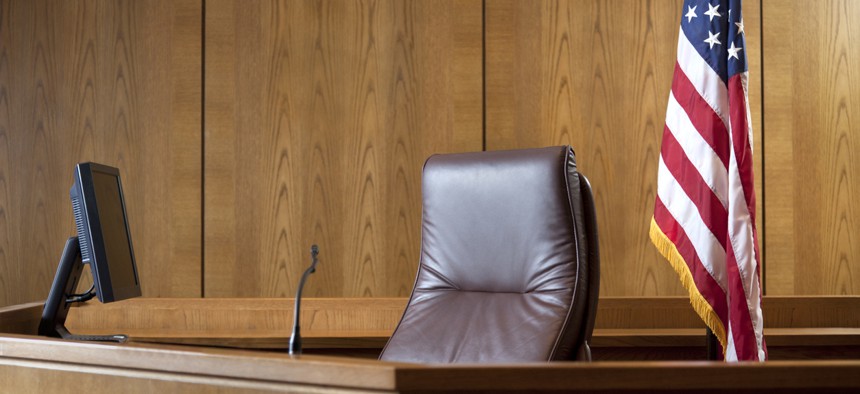The Court is Now in (Virtual) Session: How Remote Services are Transforming the Judicial System

Courtroom bench in a wood panneled courtroom. iStock.com/JasonDoiy
COMMENTARY | The judicial system has been slow to adopt technologies, but the Covid-19 crisis has initiated a digital transformation that is here to stay.
Stability and predictability are fundamental to “the rule of law,” and are strengthened by the judicial adherence to precedence. While the judicial system thrives on these concepts, they have also imposed a rigidity that can make it difficult to keep pace with evolving technology and adapt to unconventional or unforeseen circumstances.
When Covid-19 hit, judicial systems worldwide were forced to rethink their operations and embrace emergency digital methods. The courts that had explored technological improvements prior to the pandemic thrived. For instance, Elkhart County, Indiana was able to quickly adapt to remote operations because it was already equipped with a secure videoconferencing network infrastructure. Adopting the software enabled the county’s civil, family law and even some pretrial criminal proceedings to take place with most of the participants connecting remotely. As a result, its courtrooms were able to reduce the number of cases that would have been backlogged.
However, most courts that hadn’t made these digital improvements struggled to quickly improve the technology acquisition process, quality and use of shared data—a transformation that often takes years. For example, a patent case in Texas resulted in a mistrial in November because several jurors became infected with Covid-19 after several days in court. The judge then postponed all jury trials through at least March 2021, in response to the coronavirus spike and infections that spread at another jury trial in the same district.
Despite these difficulties, the benefits of remote court are undeniable. In many cases, remote court is boosting access to justice by making it easier for participants to appear. People no longer have to take a day off from work to appear for a hearing that lasts less than an hour and a half. Before the pandemic, this was something both courts and citizens found extremely disruptive, forcing some people to choose to accept criminal charges that can come with missing mandatory hearings rather than miss work and forego their earnings for the day.
Remote hearings have especially relieved a burden on lawyers, who often must appear in front of multiple judges and move from different court rooms and court houses throughout the day. In fact, the amount of time saved by conducting virtual hearings has actually allowed some courts, like Elkhart County, to clear the backlog from before the pandemic. For that reason alone, many judges believe some remote proceedings will remain in place even after pandemic restrictions start to ease.
However, for continued, long-term success of remote court, officials will need to address issues of cost, security and reliability.
The judicial sector is one of the most underfunded and overburdened government sectors, largely because of the lack of resources and increasing number of cases. While software upgrades can be costly upfront, it can ultimately help eliminate the escalating operational expenses that come with conducting court in person.
More importantly, a secure and reliable network is absolutely necessary. Given the confidential and personal legal information exchanged during remote hearings, they pose a prime opportunity for cyberattacks and data breaches. This shows that not only do courts need to equip themselves with a secure telepresence platform, but one that is specifically engineered to facilitate conversations with highly confidential information.
The same goes for reliability. Case in point, a mishap in Texas where an attorney was stuck arguing a case with a cat filter on, clearly demonstrates how certain platforms might be better equipped for professional and legal situations while others are best for virtual happy hours and yoga classes. Absent a reliable network, a host of mishaps can occur, like losing video or audio connection, which can dramatically affect the outcome of a case.
While a person’s day in court may look vastly different today than it did a year ago, the opportunity still exists thanks to connected technologies. In the coming months, expect to see an increasing amount of courts implement connected telepresence solutions that speed up docket reduction through secure real-time virtual court proceedings.
Daniel Stewart is a senior advisor of justice at Cisco. Prior to joining Cisco, Stewart served as chairman and commissioner of the New York State Commission of Correction.
NEXT STORY: Georgia Senate Approves Bill to Ease Gun Restrictions





